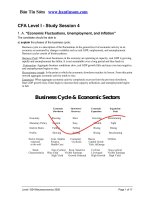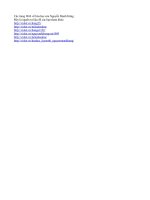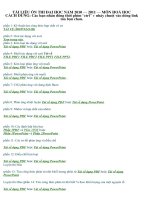Tài liệu ôn luyện thi chứng chỉ CFA
Bạn đang xem bản rút gọn của tài liệu. Xem và tải ngay bản đầy đủ của tài liệu tại đây (223.82 KB, 17 trang )
Bản Tin Sớm www.bantinsom.com
CFA Level I - Study Session 4
1. A. “Economic Fluctuations, Unemployment, and Inflation”
The candidate should be able to
a) explain the phases of the business cycle;
Business cycle is a description of the fluctuations in the general level of economic activity in an
economy as measured by changes variables such as real GDP, employment, and unemployment.
Business cycles consist of distinct phases:
Business Peak: When most businesses in the economy are operating at capacity, real GDP is growing
rapidly and unemployment has fallen. It is not sustainable over a long period and thus leads to;
Contraction: Aggregate business conditions slow, real GDP growth falls and may even turn negative,
and unemployment begins to rise.
Recessionary trough: Is the point at which the economic slowdown reaches its lowest. From this point
onward aggregate economic activity tends to rise;
Expansion: When aggregate economic activity completely recovers from the previous slowdown.
Real GDP growth rises, firms begin to increase their capacity utilization, and unemployment begins
to fall.
Business Cycle & Economic Sectors
Economic
Slowdown
Slowdown/
Recovery
Economic
Expansion
Expansion/
Peak
Economy Slowing Slow Growing Decelerating
Monetary Policy Neutral Easy Neutral Tight
Interest Rates Falling Falling Rising Rising
Profits Slowing Falling Rising Decelerating
Sector Groups Cons. Staples Consumer Basics Utilities
expected Finance Cyclicals Capital Goods
to do well Health Care Tech. &Energy
Stock Non-Cyclical Econ. Sensitive Cyclical Non-cyclical
Characteristics Blue Chip Visible Earnings Leveraged Visible Earnings
High Yield Growth Oriented High Growth High Yield
Level I SS4 Macroeconomics 2005 Page 1 of 17
Bản Tin Sớm www.bantinsom.com
b) describe the key labor market indicators and discuss the problems in measuring
unemployment;
Key labor market indicators are:
Civilian Labor Force: Number of persons 16 years of age or greater who are either employed or are
actively seeking work.
Unemployed: Person who is not currently employed who is either (1) actively looking for a job or (2)
waiting to begin or return to a job.
Labor Force Participation Rate: Number of persons in the civilian labor force who are 16 years or
older who are either employed or actively seeking work as a percentage of the total civilian
population 16 years of age or older.
Unemployment Rate: Percentage of persons in the labor force who are currently unemployed.
Problems in measuring unemployment include; (1) do not count discouraged workers as unemployed
because they have given up looking for jobs; (2) do not adjust for underemployed workers, those
working part-time who would prefer to be working full-time, and (3) do not count non-market
employment such as stay-at-home fathers/mothers as employed, even though they would be
considered “employed” if working as maids, cooks, or nannies.
c) describe the three types of unemployment;
Frictional Unemployment: Due to changes in the economy that prevent qualified workers from being
immediately matched up with existing job openings. Frictional unemployment arises from incomplete
information on the part of both employers and the unemployed.
Structural Unemployment: Due to the structural characteristics of the economy that make it difficult
for job seekers to find employment and employers to hire workers. Generally arises as result of
mismatches between existing labor force skills and employer skill needs.
Cyclical Unemployment: Due to business cycle fluctuations in overall economic activity.
Unemployment rises during recessionary periods and falls during expansionary periods.
d) define and explain full employment and the natural rate of unemployment;
Full Employment: Level of employment that results from the efficient use of the labor force after
making allowance for the normal rate of unemployment consistent with information costs, dynamic
changes and structural characteristics of the economy.
Natural Rate of Unemployment: Long-run average level of unemployment due to frictional and
structural conditions in the economy’s labor markets. This level is not set in stone but rather is
affected by dynamic economic change and public policy over time.
e) define inflation and calculate the inflation rate;
Inflation: The sustained rise in the general level of prices of goods and services in the economy.
Annual inflation rate is calculated as the percent change in a chosen price index (PI).
1
1
Inflation rate 100
t t
t
t
PI PI
PI
-
-
-
= ´
Level I SS4 Macroeconomics 2005 Page 2 of 17
Bản Tin Sớm www.bantinsom.com
f) discuss the harmful consequences of inflation.
Anticipated Inflation: An increase in the general level of prices that was expected by most decision-
makers on the economy.
Unanticipated Inflation: An increase in the general level of prices that was not expected by most
decision-makers on the economy.
1. Unanticipated inflation alters the outcome of long-term projects, increases the risks of long-term
investment activities, and so reduces the amount of long-term investment undertaken. Less
investment today is likely to lead to lowers levels and growth of output in the future.
2. Inflation distorts the information contained in prices. This distorts the signals of scarcity or plenty
contained in prices, reducing the effectiveness of markets and harming economic activity.
3. High and variable rates of inflation lead people try to protect themselves from inflation risk. This
is likely to harm current production as resources are devoted to inflation protection.
1. B. “Fiscal Policy”
The candidate should be able to:
a. explain the process by which fiscal policy affects aggregate demand and aggregate supply;
Fiscal policy affects AD directly through gov’t spending & indirectly through effects of taxes
on consumption and investment. Taxes may affect AS by changing incentives for workers and
firms. Fiscal policy can be restrictive (lowers AD) or expansionary (raises AD).
b. explain the importance of the timing of changes in fiscal policy and the difficulties in
achieving proper timing;
Recognition lag, implementation lag before policy passed, effectiveness lag before policy
works. If timed correctly can stabilize economy, if not policy will bring more instability
(usually in opposite direction).
c. discuss the impact of expansionary and restrictive fiscal policy based on the basic
Keynesian model, the crowding-out model, the new classical model, and the supply-side
model;
• Keynesian model assumes SRAS upward-sloping. If economy is in recession (below
LRAS), expansionary fiscal policy shifts out AD, and moves economy back to LRAS.
• Crowding out model similar but notes expansionary fiscal policy raises gov’t deficit,
which changes interest rates and exchange rates. These changes lower investment and net
exports, partly offsetting expansionary fiscal policy.
• New Classical model believes fiscal policy has no effect because any change in deficit
(from spending or tax changes) is offset by changes in private savings behavior.
• Supply-side model believes tax changes affect productivity and so can increase
equilibrium output in long run.
Level I SS4 Macroeconomics 2005 Page 3 of 17
Bản Tin Sớm www.bantinsom.com
d. explain how and why budget deficits and trade deficits tend to be linked.
Nat’l Income identity Y = C + I + G + NX
Rearrange yields: Y- C - G = I + NX or (Y-C-T) + (T-G) = I + NX
Where Y-C-T = Private Saving = S, T-G = Budget Balance
If S and I fixed, then increase in Budget Deficit, {(T-G) more negative}, implies that NX more
negative, i.e. larger Current Account Deficit.
e. identify automatic stabilizers and explain how they work, etc.
Automatic stabilizers are fiscal policies that automatically promote budget deficits during
recessions and surpluses during booms. Examples are unemployment compensation, corporate
profits tax, and progressive income tax. These policies affect AD in ways that offset economic
fluctuations.
f. discuss the supply-side effects of fiscal policy.
Changes in tax rates, particularly marginal tax rates, affect aggregate supply through their
impact on the relative attractiveness of productive activity in comparison top leisure and tax
avoidance. Supply-side tax cuts are a long-term growth-oriented strategy that will eventually
increase both SRAS and LRAS.
g. explain the relationships among budget deficits, inflation, and real interest rates;
In theory, higher gov’t budget deficits should lead to higher real interest rates by loanable
funds market analysis. In practice effect is not as strong as expected.
Higher gov’t budget deficits may lead to higher inflation rates and higher nominal interest
rates if gov’t finances deficit by printing money.
1. C. “Money and the Banking System”
The candidate should be able to:
a. identify and explain the three basic functions of money.
At a theoretical level, money supply consists of assets that act as:
• Medium of Exchange - facilitates transactions (liquidity).
• Unit of Account - used to quote prices.
• Store of Value - transfer purchasing power to future.
b. define the money supply;
At a practical level, U.S. money supply defined by 3 widely-used measures:
M1 = Currency + Traveler’s Checks + Demand Deposits +
Other Checkable Deposits
M2 = M1 + Savings Deposits + Small Time Deposits + Money Mkt. Mutual Funds
M3 = M2 + Large Time Deposits + Term Repo’s
Level I SS4 Macroeconomics 2005 Page 4 of 17
Bản Tin Sớm www.bantinsom.com
c. describe the fractional reserve banking system;
Commercial Bank activities:
• Accept Deposits : Hold Reserves : Make Loans
• Reserves are vault cash or deposits at central bank, required by central bank to hold
minimum % of deposits, Reserve requirement, rr.
Required Reserves = rr x Deposits
• See PP slides for more details of Commercial bank activities and role of reserve
requirement in money supply.
d. explain the relationship between reserve ratio, potential deposit expansion multiplier, and
actual deposit expansion multiplier.
Potential Deposit Expansion Multiplier = 1/(Reserve Requirement)
• Maximum potential increase in the money supply as a ratio of new reserves injected into
the banking system
Actual Deposit Expansion Multiplier
• Multiple by which a change in reserves changes the money supply
• Inversely related to the reserve requirement
• Smaller than the Potential Deposit Expansion Multiple to the extent that:
i. Persons hold currency rather than deposit it in the banking system
ii. Banks fail to lend out all excess reserves, i.e. banks choose to hold reserves in excess
of the legal minimum required.
e. describe the tools that a central bank can use to control the money supply and explain how
a central bank can use monetary tools to implement monetary policy.
Open Market Operations:
• Purchase or sale of gov’t bonds by the central bank.
• Open Market purchase of bonds by central bank increases reserves at banks, banks lend
excess reserves, and money supply increases.
Reserve Requirements
• Gov’t regulates banks’ minimum reserve-deposit ratios.
• Increase in reserve requirements, lowers money multiplier, and so decrease money
supply as banks call loans to build up reserves.
Discount Rate
• Interest rate on reserves borrowed from central bank.
• Lower discount rate, cheaper borrowed reserves, more reserves borrowed by banks,
banks increase loans, which increase deposits in banking system, thus increasing
money supply.
f. discuss potential problems in measuring an economy’s money supply.
Growth rate of money supply generally used to gauge monetary policy. Money supply
measures subject to changes due to structural shifts & financial innovations.
i. Use of U.S. $ outside of U.S. – US$ acts as international vehicle currency in
international transactions, illegal activities, dollarisation, etc.
Level I SS4 Macroeconomics 2005 Page 5 of 17
Bản Tin Sớm www.bantinsom.com
ii. Shifts from interest-bearing checking accounts to MMDA’s – checking accounts in
M1 but MMDA’s only in M2. Distorts M1 vs. M2 measures.
iii. Increased availability of low-fee stock and bond mutual funds – Not counted in money
measures but increasingly liquid, act as near-money.
iv. Debit cards and electronic money – Reduce reasons to hold currency, may transfer
transaction balances outside banking system.
1. D. “Modern Macroeconomics: Monetary Policy”
The candidate should be able to:
a. discuss the determinants of the demand for and supply of money;
Market for Money:
Money Supply: M
s
= M
0
• Set by the Central Bank using monetary policy instruments.
Money Demand: M
d
= P*L(r, Y)
• Interest rate is opportunity cost of holding money.
• Transaction demand depends on Real GDP, Y and on the level of prices, P,
in the economy.
Equilibrium: M
0
/P = L(r, Y)
• Keynesian Theory of Liquidity Preference says real interest rate moves to equate
demand and supply at any level of real GDP, Y.
b. discuss how anticipation of the effects of monetary policy can reduce the policy’s
effectiveness;
To the extent that the effects of monetary policy are fully anticipated, they exert little impact
on real activity, only nominal variables change.
Expectations of inflation will affect nominal interest rates quickly, keeping real interest rate
constant, reducing impact on AD.
Escalator clauses in wages automatically raise costs, shifting SRAS & economy more quickly
back towards LRAS.
c. identify the components of the equation of exchange, and discuss the implications of the
equation for monetary policy;
Equation of Exchange states that MV = PY
where Y = Real GDP, P = Implicit GDP Price Deflator, M = Money Supply, and V= Velocity
of Money.
If one assumes that Velocity is constant, or changes slowly, then a change in the money
supply, M, must result in the same proportionate change in Nominal GDP, PY. This is
equivalent to saying that expansionary monetary policy shifts out the aggregate demand curve.
How this increase is split between a price increase and an increase in output depends on the
slope of the Short Run Aggregate Supply curve.
Level I SS4 Macroeconomics 2005 Page 6 of 17









